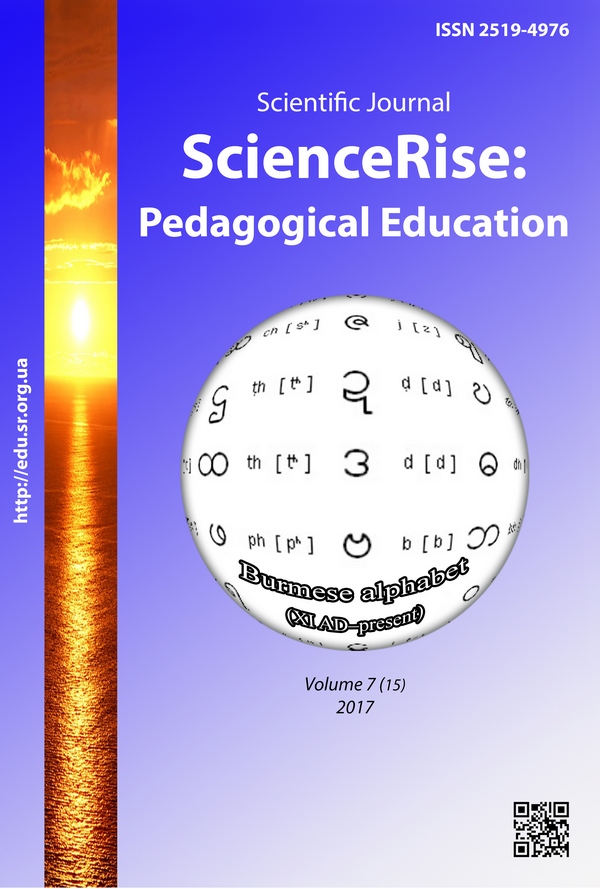Research of the spread of diseases of teeth hard tissue amond students
DOI:
https://doi.org/10.15587/2519-4798.2017.108064Keywords:
raised rub of teeth hard tissues, non-carious teeth injuries, young peopleAbstract
In the work are presented the results of the complex dental examination of 209 students of a higher educational institution of Kyiv city. It was elucidated, that young people need primary, secondary and tertiary prophylaxis of dental diseases. At the study patients were divided by sex differences, bite type, clinical course form (generalized, localized), injury depth (first, second, third degree), depending on the rubed area (horizontal, vertical, mixed) of teeth.
Methods: The dental examination of students, studied in a higher educational institutions of Kyiv city. Among them women were– 114 (54,5%) persons, men – 95 (45,5%) persons.
Results: The predominant part included students with the orthognathic bite – 159 persons, with direct – 29, and with deep – 21 persons. 1 – degree of teeth rub prevails - 110 persons, 2 degree - 68 persons. The generalized form was diagnosed in 120 persons, localized in 89 persons, compensated in 34 persons, subcompensated 52 persons, decompensated in 23 persons.
Conclusions: The causes of the pathological rub of teeth hard tissues are the functional inferiority of teeth hard tissues, intake of acid-containing products and medicaments, use of abrasive teeth pasts and hard teeth brushes or their irrational use, horizontal movements at teeth brushing, pathological bite, teeth vestibuloposition, teeth necks baring, supra-contacts
References
- Fedoseyevskaya, L. V., Al'bickiy, V. Y. (2007). Status and health problems of students. Мoscow: Litterra, 192.
- Tkachenko, I. M. (2011). Etiological factors in the development of palmar tooth enamel rubbing. Bulletin of biological and medical problems, 2 (10), 48–51.
- Alimskiy, A. V. (2007). The role of social and demographic factors in the study of epidemiology of dental disease. Dentist, 11, 3–10.
- Ilyinich, V. I. (2008). Physical culture and student life. Мoscow: Gardariki, 366.
- Kaplan, Z. M. (2007). Medico-social bases of formation of the dental health of youth. Moscow, 27.
- Chizhikova, T. S., Solomatina, E. S., Yaradaykina, M. N. (2012). Effectiveness of treatment and prevention activities among students with the pathology of the occlusal relationship. Topical issues of Dentistry. Volgograd: Volgograd Scientific Publishing House, 177–179.
- Dmitrienko, S. V., Chizhikova, T. S., Klimova, N. N. (2011). Characteristics of those groups of students in orthodontic treatment. Fundamental research, 6, 108.
- Azpeitia-Valadez Mde, L., Rodriguez-Frausto, M., Sanchez-Hernandez, M. A. (2008). Prevalence of dental fluorosis in children between 6 to 15 years old. Revista Medica Del Instituto Mexicano Del Seguro Social, 46 (1), 67–72.
- Andrian, A. A., Shlykova, A. V. (2013). Rehabilitation of a patient with generalized erosion of hard tissues of the third degree of teeth and prevention of possible complications. Bulletin of medical Internet conferences, 3 (3), 725.
- Blinova, E. G. (2008). Quality and lifestyle of students. Gastroenterology, 6 (46), 73–75.
- Milosevic, A. (2011). The problem with an epidemiological index for dental erosion. BDJ, 211 (5), 201–203. doi: 10.1038/sj.bdj.2011.722
- Kaidonis, J. A. (2012). Oral diagnosis and treatment planning: part 4. Non-carious tooth surface loss and assessment of risk. BDJ, 213 (4), 155–161. doi: 10.1038/sj.bdj.2012.722
- Ogonyan, Ye. A. (2011). Effectiveness of clinical examination of students with dental anomalies and deformations. Volgograd, 14.
- Perepechko, V. М. (2011). Gender features of dental status in patients with somatic pathology. Moscow, 24.
Downloads
Published
How to Cite
Issue
Section
License
Copyright (c) 2017 Alina Shcherbenko

This work is licensed under a Creative Commons Attribution 4.0 International License.
Our journal abides by the Creative Commons CC BY copyright rights and permissions for open access journals.
Authors, who are published in this journal, agree to the following conditions:
1. The authors reserve the right to authorship of the work and pass the first publication right of this work to the journal under the terms of a Creative Commons CC BY, which allows others to freely distribute the published research with the obligatory reference to the authors of the original work and the first publication of the work in this journal.
2. The authors have the right to conclude separate supplement agreements that relate to non-exclusive work distribution in the form in which it has been published by the journal (for example, to upload the work to the online storage of the journal or publish it as part of a monograph), provided that the reference to the first publication of the work in this journal is included.









